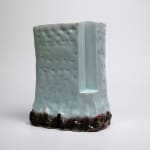Yoshikawa Masamichi 吉川正道 b. 1946
H28.5 × W22.5 × D14.5 cm
Further images
-
(View a larger image of thumbnail 1
)

-
(View a larger image of thumbnail 2
)

-
(View a larger image of thumbnail 3
)

-
(View a larger image of thumbnail 4
)

-
(View a larger image of thumbnail 5
)

-
(View a larger image of thumbnail 6
)

-
(View a larger image of thumbnail 7
)

-
(View a larger image of thumbnail 8
)

Born in Chigasaki City in Kanagawa Prefecture, Yoshikawa Masamichi (b. 1946) graduated from the Nippon Design Institute before relocating to Tokoname, where he began working at the Tobosugi Kiln. In the late 1960s, he studied under Sugie Junpei (杉江淳平), who was known for his sculptural objet d'art works. Yoshikawa, however, remained more drawn to the vessel form—creating tea cups and flower vessels using sometsuke techniques.
A pivotal influence in his artistic development came from his encounters with East Asian tombs, especially the grand burial sites of ancient Chinese emperors. This exposure inspired his signature Kahyo series (華俑)—a term that can be interpreted as "flower tomb figurines," drawing parallels to Chinese terracotta warriors and Japan’s haniwa figures.
Yoshikawa begins each work with a solid block of porcelain, carving into it and forming divisions using only his fingers. He allows the clay to dry slowly and naturally over several months before firing and glazing. The thick, cascading glazes, typically in seihakuji (bluish white) or seiji (celadon), flow and pool dramatically, often dripping and collecting at the base like frozen waterfalls.
This Kahyo sculpture evokes the verticality of urban high-rise buildings, their tall, linear forms segmented with clean incisions. Unlike other Kahyo, which lean more clearly toward funerary imagery, these resemble architectural structures more than ancient tombs. Yet the way the glaze softens and distorts the silhouette gives the impression that the forms are slowly melting, imbuing them with a quiet, haunting presence. This ambiguity, between permanence and dissolution, speaks to the transient beauty that Yoshikawa often seeks to express in his work.







